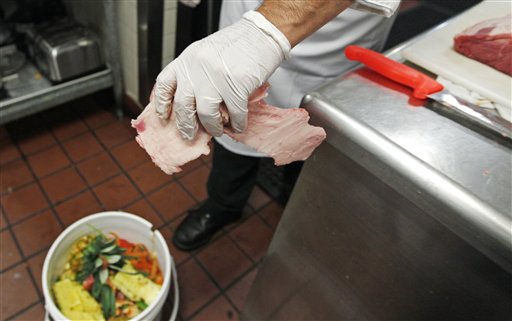MIDDLETON, Mass. — Down the back stairs of the clubhouse kitchen, on a plot lost among the expanse of tightly trimmed fairways and greens, weeks-old food is buried under a tarp and mulch and left to decompose.
But this private country club in Massachusetts isn’t taking an unsanitary shortcut with its trash. It’s trying bokashi, an obscure composting method it says will help it recycle 4 tons of food waste each year.
Bokashi is based on an ancient Japanese practice that ferments food waste by covering it with a mix of microorganisms that suppress its smell and eventually produce soil. Bokashi is not widely used in the United States, but its practitioners think it should be.
At Ferncroft Country Club, owner Affinity Management decided to start bokashi last month after trying it successfully at a public golf course it operates in Maryland.
Advocates say the key advantage of bokashi, if done correctly, is that the microorganisms involved don’t produce foul odors as they break down the food. So people can toss in meat, and even small amounts of dairy and oils, unlike in other composting methods. That eliminates much of the waste sorting that can make composting impractical for a larger food establishment. And the treated food won’t turn stomachs or attract pests.
At Ferncroft, a mild smell is apparent only within inches of the food, which is first fermented in a sealed container. There’s no smell near the pile where the food is later buried, and it appears untouched by varmints as it breaks down into soil.
“I’ll be honest with you. I thought by now we were going to see a hole, a nibble or something. It’s nothing,” said executive chef Stephane Baloy, who runs Ferncroft’s program.
Though little-known, bokashi has appeared in recent decades in pockets around the country, from Arizona to Brooklyn. But the Environmental Protection Agency doesn’t list it as a composting method and has no information on it, according to a spokeswoman.
At the U.S. Composting Council, Leanne Spaulding said there’s almost no credible research on the practice. She said there are questions about whether there’s enough space in crowded urban settings for the soil that would be produced by widespread bokashi use. And she said some see bokashi as a “gimmick” because the commercial product that’s widely used by practitioners today is made up of microorganisms that occur naturally everywhere.
Bokashi traces back centuries to Japanese farmers who covered food scraps in their rich, regional soil, which contained microorganisms that would ferment the food. After a few weeks, they’d bury the waste. Two or three weeks later, it was soil.
Today, bokashi practitioners often get the needed microorganisms from a product first sold in the early 1980s called Effective Microorganisms (EM1), which is distributed by a Texas-based company called TeraGanix. The product is no gimmick, said executive vice president Eric Lancaster, but rather a way to help bokashi practitioners avoid a stinking mess by assuring them they’re getting the right mix of microorganisms every time.
The EM1 is mixed with some kind of carbon it can stick to, such as bran or sawdust, as well as molasses or another sugar the microorganisms can feed on. Practitioners then layer the concoction on newly disposed food and seal it in an airtight bucket. Weeks later, it’s taken out of the bucket and buried.
There’s little smell with properly done bokashi because the microorganisms that break down the food produce amino acids and small amounts of alcohol. Those don’t stink like the ammonia and hydrogen sulfide produced by other microorganisms when food is left to rot, said Joshua Cheng, an associate professor of earth and environmental sciences at Brooklyn College.
Cheng is doing research on bokashi, some of it funded by TeraGanix, to better understand the chemistry behind how the food breaks down, the quality of the soil produced and to document the claims about a lack of odor. He’s also trying to make sure there are no pathogens produced — a concern in any composting process.
“There are not supposed to be, but we need to make sure that there is not,” Cheng said.
Bokashi advocates believe the practice will see wider adoption if people can get word about it, just because the amount of food wasted in the U.S. is so staggering. According to the EPA, the U.S. generated more than 34 million tons of food waste in 2010, accounting for 14 percent of all the solid waste that reached landfills or incinerators.
Vandra Thorburn, who runs a business in which she provides and collects bokashi buckets from about 50 customers around Brooklyn, said she’s making it her personal mission to get bokashi listed by the EPA. Contrary to concerns that cities don’t have space for bokashi, she said the unobtrusive method produces soil that could fill community gardens or revitalize worn or contaminated soils around the city.
At Ferncroft last week, Baloy surveyed his new herb and seasonings garden, which he’ll fill with the soil produced by bokashi. He said he’s liked what he’s seen from the process. But it’s early.
“It’s still pretty new,” Baloy said. “We’re seeing how it goes.”
Send questions/comments to the editors.



Success. Please wait for the page to reload. If the page does not reload within 5 seconds, please refresh the page.
Enter your email and password to access comments.
Hi, to comment on stories you must . This profile is in addition to your subscription and website login.
Already have a commenting profile? .
Invalid username/password.
Please check your email to confirm and complete your registration.
Only subscribers are eligible to post comments. Please subscribe or login first for digital access. Here’s why.
Use the form below to reset your password. When you've submitted your account email, we will send an email with a reset code.